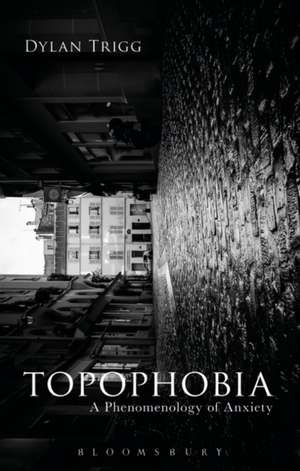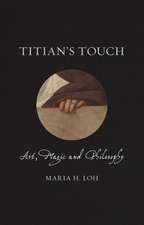Topophobia: A Phenomenology of Anxiety
Autor Dylan Triggen Limba Engleză Paperback – 14 dec 2016
| Toate formatele și edițiile | Preț | Express |
|---|---|---|
| Paperback (1) | 179.10 lei 6-8 săpt. | |
| Bloomsbury Publishing – 14 dec 2016 | 179.10 lei 6-8 săpt. | |
| Hardback (1) | 712.49 lei 6-8 săpt. | |
| Bloomsbury Publishing – 14 dec 2016 | 712.49 lei 6-8 săpt. |
Preț: 179.10 lei
Preț vechi: 207.80 lei
-14% Nou
Puncte Express: 269
Preț estimativ în valută:
34.27€ • 35.78$ • 28.36£
34.27€ • 35.78$ • 28.36£
Carte tipărită la comandă
Livrare economică 04-18 aprilie
Preluare comenzi: 021 569.72.76
Specificații
ISBN-13: 9781474283236
ISBN-10: 1474283233
Pagini: 256
Dimensiuni: 138 x 216 x 16 mm
Greutate: 0.36 kg
Editura: Bloomsbury Publishing
Colecția Bloomsbury Academic
Locul publicării:London, United Kingdom
ISBN-10: 1474283233
Pagini: 256
Dimensiuni: 138 x 216 x 16 mm
Greutate: 0.36 kg
Editura: Bloomsbury Publishing
Colecția Bloomsbury Academic
Locul publicării:London, United Kingdom
Caracteristici
The vivid first person narrative is both original and compelling and makes the book accessible to a range of readers across disciplines and academic backgrounds
Notă biografică
Dylan Trigg is FWF Lise Meitner Senior Fellow in the Department of Philosophy at the University of Vienna, Austria.
Cuprins
Preface1. The Home at Night2. Under the Skin3. Two Ocular Globes4. Lost in place5. Through the MirrorConclusionIndex
Recenzii
Topophobia is not only a vital resource for any foray into the meaning of the disquieting encounter with space, but it is furthermore a text that offers the potential for pathos and solace.
Trigg's ability to bring together the philosophical, the filmic and the literary without trivialising ... makes him a writer of great importance not only to the phenomenological tradition but to contemporary thought more generally.
Readers will be captivated by Dylan Trigg's penetrating insights into and eloquent accounts of his experience of anxiety. They lead him into strikingly new and important ideas for psychology and philosophy.
Dylan Trigg's Topophobia puts you inside the phenomenology of place-related phobias, so that you can explore the modulations of such experiences as they unfold and twist themselves into an anxiety that is without boundaries. This is a true phenomenological study of how places appear cut up and displaced, how they are darkened and blindingly lit, how they overwhelm, grab you and close in, how one's body turns against itself, freezes, and starts to drift, and how others invade and obstruct one's intentions. Trigg also draws from psychiatry and psychoanalysis to map out a detailed landscape of anxiety, delivering a deep analysis of the interweaving of the conscious and the unconscious elements that constitute the phobias related to place. He shows us that anxiety and the self are always more than, and at the same time, less than personal.
Topophilia, our love of place and our embeddedness in it and indebtedness to it, is not the only story to tell about place. In Topophobia, Dylan Trigg brilliantly shows that topophobia is woven through our experience of place, from its most intimate to its most public. He is equal parts Virgil and J. G. Ballard: he is our guide into the anxious, uncanny, nausea-inducing, claustrophobic, and agoraphobic places we are seduced by and condemned to live in, and he is the one who puts into words that which haunts us.But this is not an account of the macabre, nor is it a tour of the bleak spaces of post-industrial collapse. Trigg gives us a rigorous phenomenology of the gaps and fissures of everyday place, the anxieties and ambiguities of being a body that must at some level be committed to its places, and yet which does not always experience a similar commitment in return. This book should have a rightful place for anyone interested in phenomenology, place, and body.
Trigg's ability to bring together the philosophical, the filmic and the literary without trivialising ... makes him a writer of great importance not only to the phenomenological tradition but to contemporary thought more generally.
Readers will be captivated by Dylan Trigg's penetrating insights into and eloquent accounts of his experience of anxiety. They lead him into strikingly new and important ideas for psychology and philosophy.
Dylan Trigg's Topophobia puts you inside the phenomenology of place-related phobias, so that you can explore the modulations of such experiences as they unfold and twist themselves into an anxiety that is without boundaries. This is a true phenomenological study of how places appear cut up and displaced, how they are darkened and blindingly lit, how they overwhelm, grab you and close in, how one's body turns against itself, freezes, and starts to drift, and how others invade and obstruct one's intentions. Trigg also draws from psychiatry and psychoanalysis to map out a detailed landscape of anxiety, delivering a deep analysis of the interweaving of the conscious and the unconscious elements that constitute the phobias related to place. He shows us that anxiety and the self are always more than, and at the same time, less than personal.
Topophilia, our love of place and our embeddedness in it and indebtedness to it, is not the only story to tell about place. In Topophobia, Dylan Trigg brilliantly shows that topophobia is woven through our experience of place, from its most intimate to its most public. He is equal parts Virgil and J. G. Ballard: he is our guide into the anxious, uncanny, nausea-inducing, claustrophobic, and agoraphobic places we are seduced by and condemned to live in, and he is the one who puts into words that which haunts us.But this is not an account of the macabre, nor is it a tour of the bleak spaces of post-industrial collapse. Trigg gives us a rigorous phenomenology of the gaps and fissures of everyday place, the anxieties and ambiguities of being a body that must at some level be committed to its places, and yet which does not always experience a similar commitment in return. This book should have a rightful place for anyone interested in phenomenology, place, and body.

















